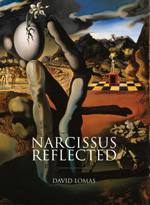 Narcissus Reflected: The Myth of Narcissus in Surrealist and Contemporary Art
Narcissus Reflected: The Myth of Narcissus in Surrealist and Contemporary Art
by David Lomas
Reaktion Books. 176 pages, $27.
THERE ARE many versions of the myth of Narcissus in classical literature, but perhaps the best known comes from the Roman poet Ovid’s Metamorphoses. Narcissus is a youth whose beauty is so powerful that women and men fall under its spell, yet none dare approach him. Not only does Narcissus enjoy the attention, he plays with the affections of those who desire him. The nymph Echo is among these, and his rejection causes her to pine away. One of Narcissus’ rejected male admirers prays for Narcissus to suffer the same fate. The goddess Nemesis answers this prayer, leading Narcissus to a still, clear pool, where he becomes entranced with his reflection, a vision that vanishes whenever he reaches for it. Eventually, he dies, his heart broken by his unattainable lover, leaving behind not a corpse, but a flower.
Jim Nawrocki, a frequent contributor to these pages, is a freelance writer based in San Francisco.






